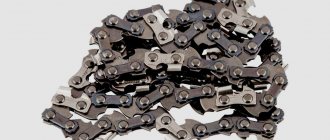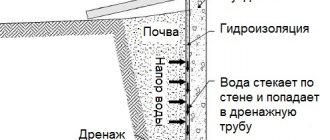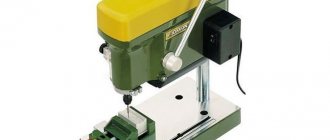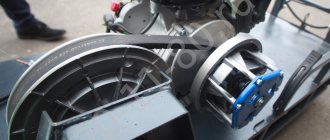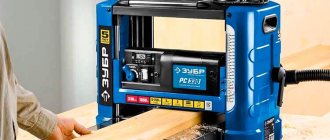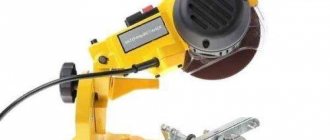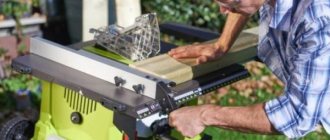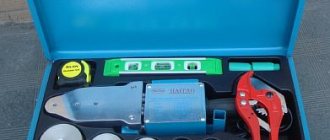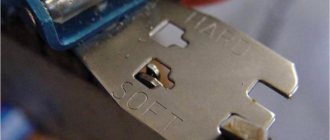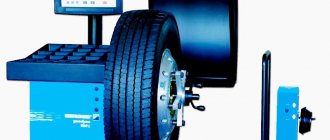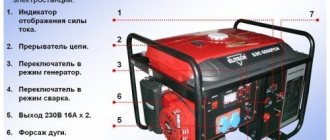The chainsaw is actively used not only for industrial purposes during construction and felling of forests, but also for domestic needs or in the country. With intensive use, it wears out, and its main cutting element, the chain, is the first to be hit.
However, constantly buying new chains is expensive, so you can buy a machine to restore the old one. Such a unit does not belong to high-tech equipment, but choosing a reliable model is not as simple as it seems.
Below is a classification of devices for sharpening gasoline saws, principles of operation, characteristics, descriptions, the study of which will help you answer what the options are, how to choose the right model, and also where to buy the best machine.
Reasons for the need to sharpen a chain
The chain has a simple design of links with teeth. They have a complex geometric shape with two perpendicularly located incisors, which perform:
- cut of the sawn surface;
- removal of chips, as well as ensuring the width of the cut.
The material is steel with a chrome coating applied on top.
Causes of dull teeth:
- intensive use of a chainsaw;
- hit by metal objects;
- improper operation;
- interaction with hard rocks.
All chainsaws require sharpening, regardless of brand or price.
It is unsafe to use a dull tool. Cutting times slow down, gas mileage increases, and increased vibration damages the frame.
Rules for extending the service life of saw chains
The saw set works in difficult conditions.
The list of negative impacts:
- lack of complete lubrication and savings on the quality of consumables;
- replacing the chain oil recommended in the instructions with cheap substitutes is inevitably accompanied by increased wear and tear of the headset as a whole;
- even expensive branded tires and chains do not withstand excessive loads typical for working with large-diameter wood;
- There are frequent cases of operating a new chain driven by a worn drive sprocket;
- the uneven stroke of the saw chain initiates additional loads on the engine and kinematics of the chainsaw.
The reasons for the premature failure of sharpening equipment may be a violation of operating rules, including unskilled care, non-functional use and work under excessive loads.
Operating principle and classification
The design is similar to a mounting saw with a grinding disc in a hanging head mounted on a support frame instead of a cutting disc.
A rotary vice fixes the saw part, and each tooth is sequentially processed with a supplied sharpener. The required angle is independently set by the operator according to the step between the links. As a rule, the thickness of the circle is 3.5 – 4.0 mm.
Safety is achieved by securely securing the tool to the workbench.
In order to process each link as sharply as possible, the disk must be positioned perpendicular to the chain. You can extend the service life by individually editing each tooth.
It should be remembered that the machine also levels the chainsaw blade. For this purpose, the smallest tooth is selected, to which all the others are adjusted. With the same dimensions, the load on the internal mechanism is reduced. In addition, alignment prevents the links from falling apart.
Advantages of manual models
The compact manual sharpening device mounted on the saw set also provides a significant gain in autonomy. The standard kit includes a holder and a set of two files - cylindrical and flat.
- An economical and affordable factory-made chain sharpening machine is suitable for productive sharpening of models of different pitch standards.
- The easy-to-use design allows you to maintain the correct sharpening angles for chainsaw chains designed for cross-cutting and more complex longitudinal cutting of fuel and construction wood.
The manual machine, reliable in everyday work, is in demand in the private sector. Specialized forestry and construction organizations prefer more advanced models.
A significant drawback of the manual device is the difficulty of finishing chains with carbide saw links. To sharpen such models, stationary machines with corundum or diamond sharpening discs are used.
Types of machines
Classification is carried out according to several parameters.
1. By drive:
- manual;
- electric.
2. By application:
- portable (mobile);
- stationary.
3. On energy supply:
- power supply 220 V;
- 12 V car battery.
4. By management:
- manual (semi-automatic);
- automatic.
Manual machines: Purpose and principle of operation
They are mechanical devices similar to a bow saw, in the form of a frame with a file attached to a chainsaw. The desired angle is set by a simple adjustment system. The depth is determined by the most worn tooth and maintained throughout the cycle.
The operation is performed by performing back-and-forth movements with the hands using a file. The efficiency of the process increases when processing first one side, then the other.
A high-quality result requires skill. Intuition and eye are of particular importance. Cooling is carried out with compressed air, after which it is immersed in engine oil.
The popularity of models is determined by the presence of advantages and the absence of disadvantages.
Advantages
- Low price when compared with electric ones;
- Ease of use;
- Small weight and size values that do not create problems during transportation;
- Compatible with any suitable files;
- Independence from power supply or complete autonomy;
- No risk of overheating;
- Minimal grinding of the cutter, which extends the service life.
Flaws
- Low productivity and labor-intensive process;
- Impossibility of maintaining an ideal angle;
- The need to count the number of file passes;
- Requirement of specific skills and knowledge of the design, angles, and abrasive sharpener used.
Not applicable to chains consisting of carbide dust links.
Semi-automatic electric machines: Composition and operating procedure
Main components:
- a bed with a fixed vice, where the guide slides are installed, as well as a depth limiter, an angle scale, a start button, and other equipment;
- asynchronous motor and abrasive sharpener on the spindle;
- clamp with fasteners.
The movable mount allows position adjustment for correct angle setting. The saw chain is placed on the slide. An attached stop plate adjusts the depth of cut. Thanks to the adjustment screw, it extends, increasing the turning depth.
Sharpening stages:
- Placing the chain in a vice on a slide.
- Rotate on a graduated scale to the required angle.
- Securing with a stopper.
- Setting the required groove depth.
- Starting the engine and moving the sharpener by the handle to the cutter to the specified depth.
- Lifting the motor head up and turning off the power.
- Unfastening and moving the link.
- Repeating the process.
After the process is completed on one side, the teeth are checked with a gauge. The chain is then turned over and the operation continues for the other side.
The device must be configured before use. Instructions are included with the kit.
Advantages
- Good performance;
- High speed;
- Ability to align teeth one by one;
- Universal functionality;
- Excellent sharpening angle with adjustability;
- Partial automation;
- Backlight;
- High security;
- Budget models with affordable prices;
- Connection to mains or battery.
Flaws
- Mandatory skills for the operator;
- The need to replace discs due to wear;
- Lack of consideration of the characteristics of each link, as well as its wear;
- Reduced resource due to a single template applied to all links.
Automatic machines
Specially designed units for the main sharpening cycle without an operator in large sawmills or repair plants. Human involvement is limited to circuit placement as well as parameter setting.
Hydraulic actuators, controlled by a controller, move the working components. Sharpening is performed simultaneously with two heads:
- from above - cutting;
- on the side – depth limitation.
The speed increases due to one pass because the upper head interacts with all the teeth in turn.
Homemade devices
If you need daily sharpening, you can make homemade sharpening devices with your own hands. These can be electric motors with an abrasive disc attached to the shaft.
The engine power should be small, and it itself should be fixed on the frame. The chain is secured with a special template, and a motor with a rotating sharpener is manually driven to each tooth.
The material being processed must be securely fixed and the motor must be movable.
How to make this type of device is clearly explained on the Internet. There you can also find out how much it costs to convert grinders or other power tools into branded units that can restore old chains.
Video tutorial “Homemade machine for sharpening saw chains”:
How to make it yourself
In this paragraph, we’ll look at how to create your own machine for sharpening chainsaw chains with your own hands at home.
Materials:
- Engine.
- Grinding wheel.
- Grinding wheel fasteners.
- Sheet steel.
- Switch.
- Wiring is insulated.
- Construction corner.
- Various small items (bolts, nuts, screws).
- Engine. Motors from old washing machines are actively used in sharpening machines. When searching for a motor, it is important to take into account the power; it must be compared with the diameter of the grinding wheel. The larger the diameter of the circle, the greater the torque the motor shaft must develop, otherwise the circle may stop under load. In purchased versions of the machines, a 250 W motor rotates the circle by 200 mm, these figures should be approximately adhered to. Of course, it is better for the machine to have a power reserve, but do not forget that the grinding wheel will decrease in diameter as it wears out.
- Base and circle. We prepare a reliable base for the sharpener (the simplest frame is made from a corner and sheet steel). We make reliable fasteners for the motor; it needs to be screwed with bolts and nuts. Grovers and nuts with plastic locking rings will not be superfluous. Many people immediately install a grinding wheel on the motor shaft; here they need to select a plus and make bushings depending on the diameter of the wheel. The circle is usually clamped with large washers on both sides; it would be a good idea to place cardboard spacers under the washers.
- Protection. Next, you need to create a special protective frame, the installation of which takes no more than twenty minutes, but during the process of sharpening something you will not be bombarded with various consumables. In this case, the protective shield is welded into the frame where necessary, secured with ordinary metal rods, pipes, and brackets.
- Emphasis. To make it comfortable and safe to work on the machine, we put emphasis on it. The emphasis must be adjusted in at least two positions - vertically and horizontally. It will move towards the grinding wheel as it wears out, and will be used in other equally important stages of work. We assemble the stop from a corner, plates and sheet steel, and we find the drawings on the Internet or invent them ourselves, since the mechanism is simple. You can also weld pipes to the nuts, and insert steel rods into the pipes as the main handles - it will be much more convenient to use the device.
- Shield cover. We are making a cover for the shield; it should be removable so that the circles can be replaced as needed. We cut out the cover itself from sheet steel and drill holes in it. We weld bolts or threaded rods to the shield itself; as a result, the cover will be secured with nuts. It would be a good idea to make a window at the bottom of the shield through which excess debris will pour out.
- Final touches. At the end, you need to make a sleeve with wiring, install a reliable switch and paint the machine in your favorite color (this will make the work process much more interesting). The homemade product looks great and works flawlessly. There is another axis on the back of the motor; you can put a brush or polishing wheel here. This completes the project, I hope you liked the homemade product and found something interesting. Good luck and creative inspiration if you decide to do this again. Also, think about the cost of such a device and find out how much a machine for sharpening chainsaw chains costs directly from the store.
You may be interested in: Review of the best gasoline trimmers: TOP 7 rating, characteristics and reviews
Practical recommendations for choosing
Before choosing which machine is best to buy, you need to get acquainted with this tool by studying the technical parameters and ratings, and also listen to expert advice on what to pay attention to. It is necessary to present the basic principles of operation, as well as determine the planned volumes in advance.
Main selection criteria
1. Nature and operating conditions:
- landline or mobile;
- manual or semi-automatic (automatic).
2. Price.
If you use it infrequently, there is no point in buying an expensive professional model.
3.Technical parameters:
- RPM demonstrates speed and sharpening qualities. For occasional use, 3000 rpm is sufficient. For daily use or large volumes, it is advisable to consider tools with values up to 7.5 thousand rpm;
- The size of the abrasive disc determines the purpose: up to 145 mm - manual models, up to 250 mm - stationary devices, up to 400 mm - industrial units.
- power determines the frequency of use and mobility: up to 220 W are popular models for household devices, and professional ones are equipped with more powerful electric motors to increase load resistance.
4. Equipment with additional functions:
- rotation of the grinding head or clamping block;
- cooling system;
- wet grinding;
- tension regulation;
- backlight;
- additional functions of a specific product.
5. Complete set:
- the product itself;
- grinding discs of different thicknesses;
- calibers;
- additional keys;
- instructions, manuals, reviews.
6. Security:
- casing;
- additional screen;
- clear insert material for control and protection;
- automatic power off.
Stationary models with electric drive
In order to sharpen a chainsaw chain on a stationary machine, just hold it in a vice and set the specified angle. Manual supply of a 3.5 mm thick sharpening disc to each cutting link is simplified by the availability of visual control.
The productivity of stationary sharpening devices is determined by the spindle speed. For different models, this figure varies in the range from 3 to 7 thousand rpm.
Technically advanced professional machines have a function of rotating the working head, which makes it possible to bring the sharpening disk to the cutting edges at any angle.
Summarizing
Thus, the best machine is a device that meets the stated requirements in all respects and has positive reviews from users. By comparing the parameters of most products, you can choose an excellent option, new items from universal models at an affordable price.
It is important not to make mistakes when choosing. It should be remembered that the Russian supply market is almost 20% filled with counterfeits from China, copying the external forms of instruments from recognized manufacturers. Therefore, buying a cheap machine made by unknown craftsmen may turn out to be a bad purchase. In this case, it will not meet the requirements and will not provide warranty obligations.
The question of which company’s product is best to buy can only be resolved by contacting stores or representative offices of trusted companies that have the necessary licenses. The best manufacturers value their reputation.
Enjoy the shopping!
Eliminating the risk of purchasing a counterfeit
Less successful may be the choice of a cheap chain saw sharpener of unknown origin. This model does not fully comply with modern requirements and is not provided with warranties and spare parts.
On the domestic market, 15-18% of the total volume of offers for the sale of sharpening machines is made up of Chinese counterfeits, in some cases successfully copying the best examples of branded manufacturers.
The risks of purchasing a counterfeit are eliminated by purchasing the selected model in licensed stores or sales representative offices of dealer structures.
